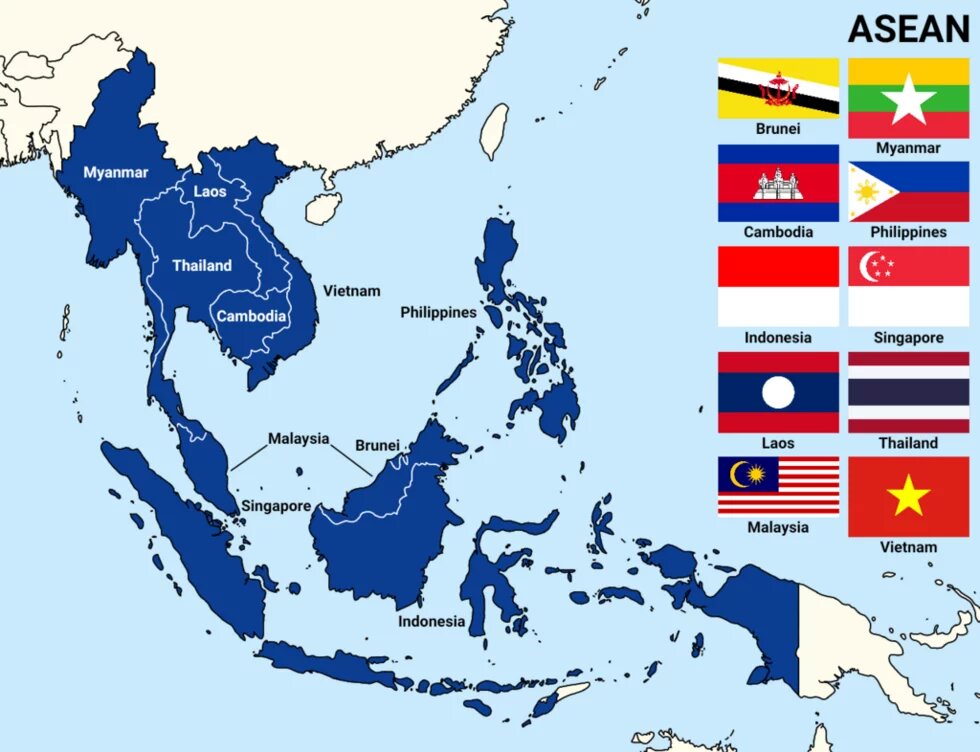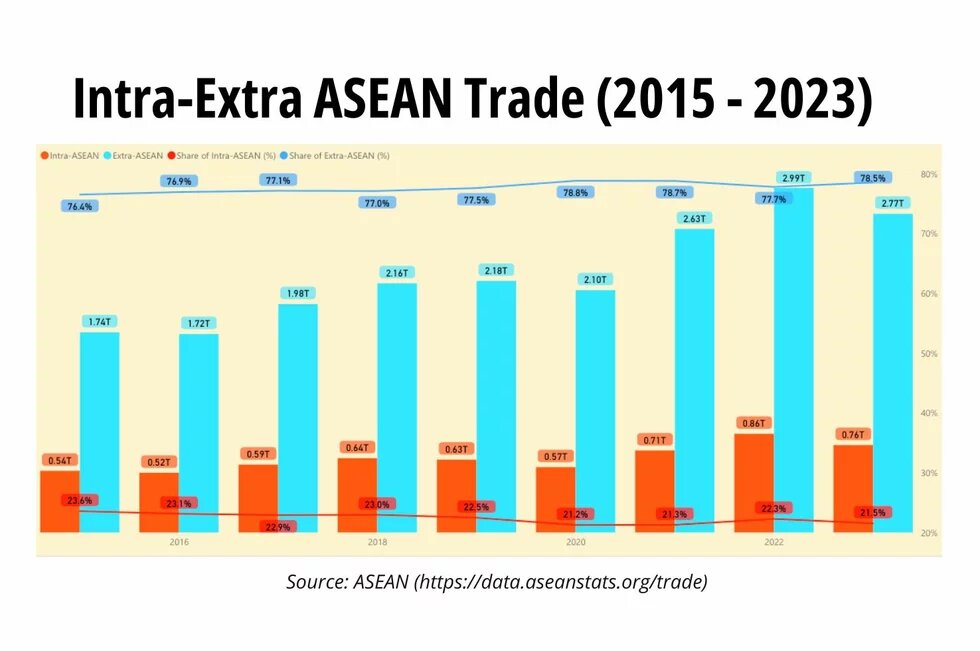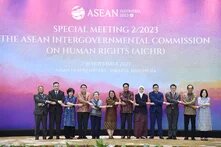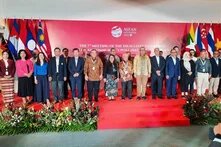
ASEAN is navigating turbulent waters. As US-China tensions escalate and Trump's return brings a new wave of tariffs, Southeast Asia’s hard-won gains are under threat. Once a quiet beneficiary of trade diversion, ASEAN now faces shrinking space for neutrality. ASEAN needs to hunker down and address its chronic weaknesses – as well as look beyond the big powers.

In just half a year, the world as seen through Southeast Asia's eyes has changed dramatically.
In December, just before the start of Malaysia's role as ASEAN chair this year, Prime Minister Anwar Ibrahim spoke of an ASEAN that aims to influence the world, a player on the brink of "a second renaissance". In May 2025, he opened the ASEAN summit on a different note, saying ASEAN needs to use its "fortitude and staying power to withstand the headwinds and weather the storms of the challenges and uncertainties facing us."
"A transition in the geopolitical order is underway and the global trading system is under further strain, with the recent imposition of US unilateral tariffs," Anwar said. At the ASEAN foreign ministers' meeting in July, he said: "Tariffs, export restrictions and investment barriers have now become the sharpened instruments of geopolitical rivalry."
ASEAN is trying to make sense of a turbulent international landscape in both the geoeconomic and geopolitical spheres.
In April, ASEAN found itself hit hard by US President Donald Trump's tariffs. Individual countries have been making offers to get the rates reduced before the announced implementation date of August. Vietnam and Indonesia have reached trade deals by giving the US full access to their markets.
Days after their leaders' summit on 26 May, ASEAN countries listened to US Defence Secretary Pete Hegseth describe Southeast Asia through its lens of deterring "Communist China" at the Shangri-La Dialogue in Singapore. While they have a "geographic necessity" to seek economic cooperation with China and defense cooperation with the US, he said: "Beware the leverage that the CCP [Chinese Communist Party] seeks with that entanglement. Economic dependence on China only deepens their malign influence and complicates our defense decision space during times of tension."
At the US dialogue with ASEAN foreign ministers in July, US Secretary of State Marco Rubio said, "The United States is a committed partner to ASEAN". But it was also around this time that Trump sent letters to many countries, ASEAN nations included, updating unilateral tariffs that pry their markets open to US goods.
ASEAN's DNA
These 'messages' from Trump's United States strike a discordant note with ASEAN, whose DNA is multilateralism – whether in trade or diplomacy – as a default mode of operation, a tool for development and shaping the regional architecture.
Global rules and norms, after all, are more valuable to smaller or less powerful countries. Given how its member states were divided along Cold War fault lines, ASEAN does not see the world as an 'either-or' one and is allergic to being locked in any power's corner.
It sees its capital as a club that has criss-crossing political, security and economic ties, can draw rivals into the same room, and talk to anyone and everyone.
While ASEAN is no stranger to making its way through geopolitical rivalry, the antagonistic turn in US-China ties threatens to shrink the strategic space it has nurtured for itself.
"ASEAN's modus operandi is to engage with both sides and to hope that a bit of competition is good. It gives ASEAN space and to be able to play one against the other probably, but a real clash would be very difficult for ASEAN," Dewi Fortuna Anwar, who is with the Social Science Commission of the Indonesian Academy of Sciences and chairwoman of The Habibie Center's board of directors, said in the 'Straight Talk Southeast Asia' podcast.
"When we talk to the Americans and Chinese, we say two things. Number one, don't make us choose," Joseph Chinyong Liow, dean of the college of Humanities, Arts and Social Sciences at Singapore's Nanyang Technological University, said at a May discussion on US and Southeast Asia ties at Columbia University's Weatherhead East Asian Institute. "Number two, please view Southeast Asia for who we are, and don't view us through US-China, the lens of competition that the two of you have." At the same time, ASEAN is very tuned in to how powers react to its engagement with them, he points out.
At the Shangri-la Dialogue, Prime Minister Anwar said: "What Southeast Asia needs is a dynamic equilibrium that enables cooperation without coercion, and balance without bloc politics."
Preserving autonomy
ASEAN is far from homogenous, but has been able to hold a consensus among its members on managing the big powers' contest for influence – even though subsets of its members do navigate more in the orbit of China or the US.
The US' military and security relationships with ASEAN countries are a security pillar in the Indo-Pacific. Since 2022, under the Biden administration, there has been a US-ASEAN 'Comprehensive Strategic Partnership' in place. The US is the leading investor in the region, accounting for over 22% of foreign direct investments in ASEAN.
But ASEAN and China are each other's largest trade partners. The US is ASEAN's second largest trading partner after China. The volume of ASEAN's exports to the two powers do not vary a lot, going by 2023 ASEAN statistics. But the value of ASEAN's imports from China was more than three times that from the US (409.5 billion dollars versus 126.1 billion dollars) that year.
In 2024, the US' goods trade deficit with ASEAN stood at 227.7 billion dollars, an 11.6% increase from 2023 – a deal breaker for the Trump administration.
In their web of interactions with major powers, ASEAN countries have made deft use of the space they created to develop agency, in pursuit of their interests.
For instance, a US treaty ally like Thailand buys military equipment from China – in fact, from 2004 to 2023 it purchased more arms, in terms of value, from China than from the United States. Singapore is a key pathway for Chinese investments into Southeast Asia, but holds regular military exercises with the US. The US navy's logistical command in Singapore supports US patrols in the South China Sea – where several ASEAN nations have territorial disputes with China – and almost 1,000 members of Singapore's armed forces train in the US at any one time.
But the unpredictability of Trump's brand of international relations is a challenge.
Today's US-China rivalry, Liow said, is a situation where "you have two great powers locked in competition who are kind of not happy with where things are and want to do something about it." He added: "The US feels that it's been taken advantage of by a bunch of allies who really are not allies, but are freeloaders. The Chinese feel that they're not being given the recognition they deserve."
As ASEAN finds the US an unpredictable trade partner, feels squeezed by US-China competition and worries about a fracturing international landscape, it needs to strengthen its internal moorings. Among its list of to-dos are deepening integration among its member countries, pursuing more free trade arrangements within and without the region and more than ever, growing and diversifying its connections beyond the US and China.
ASEAN's unveiling of the 'ASEAN Community Vision 2024', its 20-year roadmap for deeper integration and better resilience, is a key part of this homework. It is a software update of sorts that includes priorities such as the green economy, the digital economy, sustainability.
Malaysia's theme as ASEAN chair, Inclusivity and Sustainability, itself reflects how the regional grouping has to put more work into its internal strength, says Thomas Daniel, director of foreign policy and security at the Institute of Strategic and International Studies Malaysia. "Inclusivity and sustainability might seem simple at the outset, but is also a demand that ASEAN step up - in mindset, policies and practices - to ensure that it remains dynamic, resilient and fit for purpose," he said. "It is as much a vision as it is a wake-up call."
In what Anwar called its "widening its strategic aperture" as part of its "habits of cooperation", ASEAN continues to talk to more countries – and markets – like the Gulf and the Europe.
The day after the ASEAN summit in May, ASEAN held the first ASEAN-Gulf Cooperation Council-China summit, a trilateral initiative that Anwar said would "connect ASEAN's energy and talent with the Gulf's capital and China's scale." It came on the heels of ASEAN's second summit with the GCC, which is made up of Bahrain, Kuwait, Oman, Qatar, Saudi Arabia and the United Arab Emirates.
"Preserving our autonomy is not about resisting others, Malaysia's Anwar said at the Shangri-la Dialogue. "It is about strengthening ourselves."
In the same event, French President Emmanuel Macron – after visiting Vietnam and Indonesia – pitched the idea of a "third way" that ASEAN and Europe can pursue as a "common agenda" through "strategic autonomy" from big powers.
"ASEAN and Europe are impacted by the unpredictability of the new tariff approach and the end of a rule-based order for our trade," said Macron, adding that France would release its updated Indo-Pacific strategy in weeks. "Both the Europeans and the Asians are much more intertwined than we thought," he explained, calling for a "coalition of independents" that want to have choice and avoid overdependence on others, and maintain a rules-based international order.
There is much catching up to do, says Celine Pajon of the Centre for Asian and Indo-Pacific Studies of the French Institute of International Relations. "The waning influence of Europe in Asia is clear, suffering from perceptions of double-standards, institutional complexities and wavering commitment to the region," she said.
While the European Union is ASEAN's third largest trade partner, its total goods in trade (299.7 billion dollars) was just over 60% of ASEAN's trade with the US (476.8 billion dollars) and less than a third of ASEAN-China goods in trade (982.3 billion dollars) in 2024.
The EU wants to pursue new-generation trade agreements with ASEAN and with the Comprehensive and Progressive Agreement for Trans-Pacific Partnership (CPTPP), Macron said. In mid-July, Indonesia and the EU agreed to finalize a Comprehensive Economic Partnership Agreement.
From dividend to vulnerability?
ASEAN countries now face the challenge of reducing the vulnerabilities that stem from the dividends they reaped from the 2018 US-China trade war under the first Trump administration. That had set off a process of trade diversion that made ASEAN economies a "connector of trade" between the two superpowers, as Sarah Chan wrote in a brief for the National University of Singapore's East Asian Institute.
In this system of recalibrated global supply chains, corporations and countries, including from China, rerouted exports to the US through countries like Vietnam, Cambodia, Thailand and Malaysia, which provided manufacturing bases to go around the US tariffs.
Trump's 2025 tariffs threaten to shut off this connector role, even as ASEAN countries have become more reliant on exports to the US, and imports as well as investments from China. Their interdependence with China has created more jobs at home, especially after the COVID-19 pandemic. ASEAN economies worry that the trade tensions will hurt their appeal as investment destinations, and cut into GDP growth rates.
Having learned its lesson from the first Trump administration – that training tariffs only at China would not fix its trade deficits – the second one is now targetting the rest of the world too, including Southeast Asia.
"ASEAN economies once again find themselves caught in the crossfire between the world’s two largest powers. This time, however, the implications are far more significant," Chan explained. "The realignment of China’s manufacturing supply chains has created jobs and entire industries over the past five years. Another shift could unwind parts of this manufacturing ecosystem and threaten people’s livelihoods."
Malaysia's earlier request for a summit with the US to discuss trade did not lead anywhere. Vietnam agreed to a 20% tariff on its exports to the US in early July, in exchange for tariff-free access by the US to its market. On 16 July, the US announced a 19% tariff deal with Indonesia. In both cases, there will be add-on tariffs (40% for Vietnam) on exports found to be transshipped – mainly goods from China's manufacturers.
In their 26 May summit, ASEAN leaders set up a high-level advisory Geoeconomic Task Force to coordinate responses.
At the same time – as it hunts for new markets – ASEAN countries worry about seeing imports flooding in from China.
What can ASEAN do? Look beyond China too, and carry more of its own weight.
"The solution lies in strengthening domestic manufacturing," Priyanka Kishore, director and principal economist at Asia Decoded, told a discussion hosted by the Singapore-based ISEAS-Yusof Institute. ASEAN should close its huge gap with China in labour productivity, she says, since ASEAN's has grown by an average of just 2.8 per cent in the last decade or less than half of China’s.
ASEAN also needs to fix a chronic weak link – the low level of trade among its 10 member states. In both Malaysia's Chairman's statement for the 46th ASEAN Summit and a separate ASEAN statement on "global economic and trade uncertainties", the association said it would strengthen its resilience by "further deepening internal trade and investment".
Intra-ASEAN trade accounted for just 21.5% of its total trade in 2024. This figure has not changed much since 2015, when the ASEAN Community was launched.
ASEAN upgraded its ASEAN Trade in Goods Agreement at the May leaders' summit. When concluded later in 2025, its digital economy framework agreement should be another integration tool, as is the rising trend in cross-border transactions in local currencies.
While the current environment holds many challenges, Daniel says ASEAN is used to having a "very long-term vision", such as its ASEAN Community Vision 2045, that sees beyond immediate concerns. "Operating with challenging internal and external realities is not new for ASEAN," he said.
"ASEAN is flawed in many ways, but it is a pragmatic organisation," Daniel explained. "This has always guided ASEAN through its many challenges, even if it has been at a slower pace than some are comfortable with."
__
Johanna Son, who has covered Southeast Asia for over three decades, is the editor and founder of the Reporting ASEAN series, whose newsletter is here.
Disclaimer: This published work was prepared with the support of the Heinrich Böll Stiftung. The views and analysis contained in the work are those of the author and do not necessarily represent the views of the foundation. The author is responsible for any liability claims against copyright breaches of graphics, photograph, images, audio, and text used.




